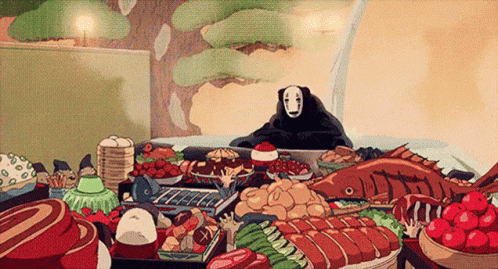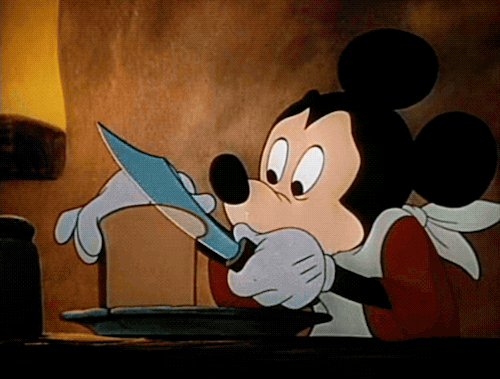We all know that food is one of life’s most wonderful indulgences (we’ve explored snacks, eggs, and infinity foods, among others). However, it seems that some of the most impeccable, irreplicable, and delectable foods exist only in the realm of fiction. We’ve collected a sampling of the best foods that fiction has to offer.
Television
The best cooking shows on television aren’t about competition or recipes, and you won’t find them on food and travel networks. Instead, they’re the ones where a character’s sense of self or aesthetics are clearly being developed through their relationship with food preparation. Like dressing oneself, gathering and cooking food is an eternal unifier that allows for infinite self-expression.

The food looks great, but the use of chiaroscuro is equally impressive.
For more thoughts on Hannibal and other murder mysteries, check out our Procedural Crime Drama Recommendations.

Hannibal
As a series, this is quite possibly the most beautiful cinematography to ever grace a network television screen. The sound, the wardrobe, the dinner/fight scene between Laurence Fishburne and Mads Mikkelsen in Hannibal’s kitchen (so intimate and beautifully choregraphed) . . . but I digress, we’re here to talk food. Created and styled by Janice Poon, the plates (of what is probably people) look like Dutch Master tablescapes, dripping with death and wealth, tempting and revolting all at once. Poon’s blog chronicles the art and skills behind the scenes with elaborate drawings and insights into the research and recipe development process if you’re into that sort of thing.
Better Things
Pamela Adlon’s character Sam is a single mother of three daughters with boy names—Duke, Frankie, and Max. The relationships are real and fraught, their day-to-day life is chaotic, and yet Sam always finds the time to spend hours preparing elaborate, homey meals for anyone and everyone under her roof at the moment. Something about her feels like she is the Carla Lalli Music of FX. When asked why she felt like it was so important to include home-cooking on the show, she replied, “It's a natural part of the way I mother.” You can see that familiarity and nostalgia in the careful kitchen lighting and humble recipe selections like borscht, carbonara, and Easter cake.

Please Like Me
In a similar vein, Josh is a messy but loveable home cook making scrappy meals and desperate attempts at connection. As a complicated work in progress, food is often the only thing Josh can offer to express his care and relate to the people in his life. The childishness and “oh-no-we-shouldn’t” of candy sprinkled throughout feels like whispering secrets in your siblings’ ear. It’s so cute and heartwarming and perfect for when you need the bingeable version of comfort food.

Is Josh Thomas the real-life Alfredo Linguini? Probably, yes.
Episode Titles
"Rhubarb and Custard"
“French Toast”
“Portuguese Custard Tarts”
"All You Can Eat"
"Spanish Eggs"
“Horrible Sandwiches”
"Milk"
"Ham"
“Parmigiana"
"Gang Keow Wan"
"Sausage Sizzle"
"Lapin La Cocotte"
"Scroggin"
"Truffled Mac and Cheese"
"Skinny Latte"
"Margherita"
"Simple Carbohydrates"
"Croquembouche"
"Natural Spring Water"
"Coq Au Vin"
"Pancakes with Faces"
"Puff Pastry Pizza"
"Amoxicillin"
"Champagne"
"Christmas Trifle"
"Babaganoush"
"Porridge"
"Beluga Caviar"
"Degustation"
"Burrito Bowl"
"Souvlaki"
The Sopranos
The Sopranos is experiencing a renaissance, and it’s not hard to see why. Beyond its incredible writing and characters, the show also alludes to food at nearly every turn. Tony comes back from a particularly grueling day of mafia goings-on? No worries, there’s spaghett’ in the fridge. Adriana is always prepared to cook up eggs for Christopher. There is a generous supply of heavily poured red wine at nearly every meal.
As much food is shown, there’s even more that’s simply discussed—and in thick Jersey-Italian accents. Good luck making it through without joyfully muttering “gabagool,” “mortadell,’” or “ricott’” to yourself. And did you know that there were two official cookbook releases based off of the recipes of Carmela and Artie? That’s how you know it’s good.

Seriously, once you notice the quantity of red wine, you can't unsee it.
🥙🍕🍚🥧🍱🥨🥘🍝🥗🍤 🥙🍕🍚🥧🍱🥨🥘🍝🥗🍤
Movies
In the world of cinema, there's less screen time to focus specifically on the practice and pleasure of cooking (unless that's what the movie is about, of course). Instead, food is often tucked into scenes, covertly building out the world and conveying the values of the characters.
Spirited Away
Hayao Miyazaki is undoubtedly a master of storytelling, and the use of food is a prime example of the richness of his films. You could pick nearly any Miyazaki movie (or Studio Ghibli more broadly) and talk about how delicious the food looks—and there are plenty of re-creations that come impressively close to the originals’ level of perfection.
That being said, there is probably no better example than Spirited Away: the film’s entire plot is kicked off by Chihiro’s gluttonous parents being transformed into pigs. Throughout the movie, characters snack on rice balls and steamed buns, but these treats don’t compare to the grandiose display of the delicacies presented to No Face, the insatiable spirit who tips generously with artificial gold.

A basket of apples and a roast fish the size of an adult person? Count me in.
Inglourious Basterds
Often, food is used as a visual representation of love, hospitality, or family. In the notorious strudel scene from Inglorious Basterds, the serving of food is instead heavy with hostile tension. That doesn’t stop it from looking incredibly delectable.
The strudel itself looks “not so terrible,” I guess, but the star of the scene is the cream. As Colonel Hans Landa insists that Shoshanna wait to eat her strudel until the cream is served, the anxiety builds: the two sit in silence. The focus is meant to be on this crucial hostility between the characters, but that cream looks so delicious it’s almost distracting. I would have wanted to wait for it too. (And not only is there a recipe, there’s also a YouTube re-creation.)

Mickey and the Beanstalk
The images of the food in Mickey and the Beanstalk, an animated Disney short released in 1947, are meant to convey the severe level of poverty that the characters are forced to endure. Mickey, Goofy, and Donald are in a state of dishevelment and disarray, but eager to enjoy a delicious meal. They begin to serve themselves from their one precious loaf of bread.
The slices of this seemingly mundane bread loaf are translucent-thin—again, to show just how hard times are—but the animation makes them seem ethereal and magical. What kind of bread can be sliced into such fine, transparent slices? The ultimate effect is that the bread looks incredibly delectable and otherworldly, although perhaps not very satisfying.

Maybe it's just the world's highest-quality knife?
Hook
Truly one of the most iconic dining scenes of all time, the technicolor pies and Renaissance Faire–fare of the Lost Boys’ fake feast are permanently seared into my memory. Yes, it looks like the crappy pastel shaving cream you were supposed to spray all over Bathtime Fun Barbie, but nothing looked more lush and delicious to my eight-year-old mind. This imaginary feast carried me through nights of PB&J poverty well into my twenties.
🥙🍕🍚🥧🍱🥨🥘🍝🥗🍤 🥙🍕🍚🥧🍱🥨🥘🍝🥗🍤
Games
This is not how we started, but we got here somehow. Honorable mentions to all the games that make digital food appealing, too.
Neopets
Neopets was the peak form of fantasy for kids growing up in the early aughts, and if you weren’t there to experience it firsthand, you probably don’t know about the rich economies and structures of Neopia. There was a robust currency, economy, stock market, gambling, shopping, gaming, forums, and banking—oh, and pets, of course.
The thing about the pets is that you have to feed them to maintain their happiness. This probably isn’t surprising. But the foods of Neopia are incredibly varied, numbering in the thousands. But for those who played Neopets, there’s no food more immediately recognizable than the omelet: distributed for free to all players once a day, the omelet was likely the most ubiquitous and accessible food (there are 129 discrete omelet varieties).

Legend of Zelda: Breath of the Wild
Cooking mechanics in games usually garner positive financial or stat-based gains, but they’re pretty boring. Breath of the Wild created a new benefit to the cooking mechanic: a great animation sequence and song to go along with the process, incentivizing cooking in a whole new way. It’s so good you almost don’t care what the end result is (they do look delicious, though).
In fact, the game’s producer Eiji Aonuma was fully aware of the importance of making cooking fun:
"To tell you the truth, I've been thinking for a long time about how I could work cooking into a game somehow. But the fact of the matter is that cooking, when you stop to think about it, is pretty boring. It's really slow work and there's not a lot you can really do to make it seem very exciting. [...] So maybe if, going forward, I can find a way to make cooking seem more exciting and allow people to have fun with it, I would probably try to put it into a game.”

The splash, the smoke, the ingredients' joyful bounce—this is cooking at its best.
Animal Crossing: New Horizons
In Season 1 of the pandemic, people were gardening, making their own designer clothes, and hanging with friends on private islands. Last year, just in time for our three-year panniversary, Animal Crossing: New Horizons introduced cooking—and with it, the most delicious-looking cartoon food since A Goofy Movie pizza. The only ugly (and therefore not delicious) items are smoothies/milkshakes; they come in an overdecorated mason jar with a handle and as a result end up looking like an obnoxious Pinterest smoothie.

Overcooked
Just play this and stop wasting money on relationship counseling. Only the strong will survive.




